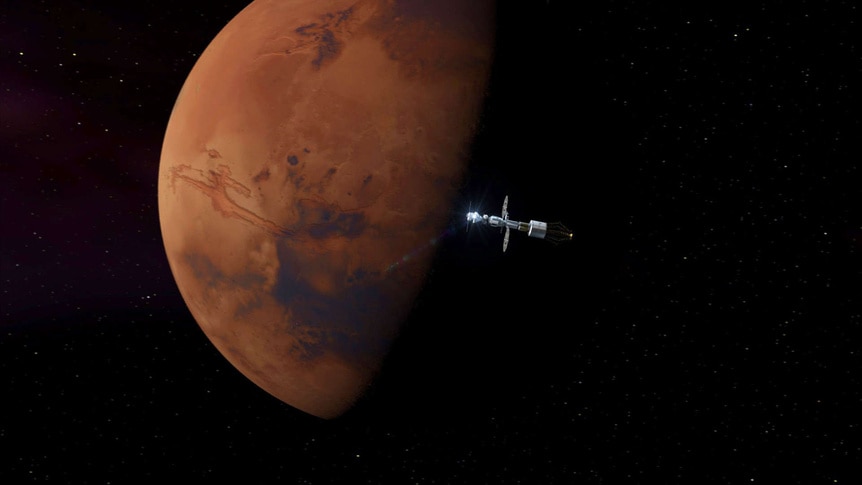Create a free profile to get unlimited access to exclusive videos, sweepstakes, and more!
How NASA's Space Launch System (SLS) Will Return Humans to the Moon
Artemis astronauts will blast off atop the most powerful rocket ever built.
In SYFY’s The Ark, engineers had to construct the largest spacecraft ever built by human hands and pack as many people and supplies inside as possible. It’s the sort of project a species might undertake only when threatened with total annihilation. In the real world, we haven’t quite been pushed to that extreme just yet, but that hasn’t stopped aerospace engineers from putting together and launching the most powerful human-rated rocket system of all time: NASA’s Space Launch System (SLS).
The SLS is a launch platform designed for deep space missions including the ongoing Artemis program, which aims to return humans to the Moon’s surface in this decade. It’s strong enough to carry the next class of lunar astronauts and cargo to the Moon’s surface and bring them home safely.
At present, it’s already overwhelmingly powerful, but the SLS is designed to evolve over time, improving its maximum thrust and cargo capabilities on future missions to the Moon, Mars, and beyond.
For More on Space:
Radiation Could Limit Mars Missions to Four Years
Odysseus Lunar Lander Returns U.S. to the Moon for the First Time in More Than 50 Years
Chimps in Space: Remembering Enos, the Chimpanzee Who Orbited the Earth
NASA’s Space Launch System (SLS) Is the Most Powerful Rocket Ever Built
When an SLS rocket launched from Launch Pad 39B at NASA’s Cape Canaveral on November 16, 2022, it was the most powerful rocket NASA had ever launched. That launch also kicked off the Artemis program with the successful liftoff of Artemis I. The mission was uncrewed, but tested the SLS, the Orion spacecraft, and other critical systems needed for the success of crewed lunar missions.
Block 1, the first and current configuration of the SLS, is designed to carry up to 59,500 pounds (27 metric tons) of cargo, including the Orion spacecraft and crew. The rocket itself is made up of three main components: the core stage of four RS-25 liquid propellant engines, two solid rocket boosters, and an exploration upper stage.
An upgraded Block 1B SLS is planned to launch on Artemis IV, with a more powerful exploration upper stage (EUS) and increased payload capabilities up to 83,700 pounds (38 metric tons). Block 2, the final planned configuration, will up the ante again with a maximum payload of 101,400 pounds or 46 metric tons.
The Block 1 SLS stands 322 feet tall and weighs 6 million pounds when fueled. It’s shorter than the famed Saturn V (the rocket which carried Apollo astronauts to the Moon) but capable of about 8.8 million pounds of thrust, roughly 15% more than the Saturn V. It can carry more cargo than the Space Shuttle could, and it can carry it not just to low-Earth orbit but all the way to the Moon, more than 1,000 times more distant.
How NASA’s Space Launch System (SLS) Works
The core stage holds 733,000 gallons of supercooled liquid hydrogen and oxygen, ready to feed the four RS-25 engines. The core stage also carries the flight computers and avionics responsible for controlling the flight during the crucial early minutes. The four RS-25 engines and the two solid rocket boosters all fire up together at launch time to lift Orion off the ground.
The boosters are spent after the first two minutes and are jettisoned back to Earth. From there, the core stage does the rest of the heavy lifting, pushing Orion into low-Earth orbit about eight minutes after launch. That’s when the core stage drops out as well, and the Interim Cryogenic Propulsion Stage (ICPS) takes over. It boosts the Orion spacecraft out of low-Earth orbit and on a rendezvous path with the Moon.
The ICPS is a single-engine propulsion system which uses a combination of liquid hydrogen and liquid oxygen for in-space propulsion. It’s made from a modified Delta Cryogenic Second Stage, originally designed for use with Delta III and Delta IV rockets. It will only kick in once the boosters and the core stage are gone and it will take astronauts the rest of the way to the Moon. On Artemis I, the ICPS was responsible for kicking Orion beyond the Moon before it returned to Earth. On later missions, the ICPS will be replaced with a more powerful Exploration Upper Stage capable of carrying Orion on the final leg to the lunar surface.
It’s the biggest and baddest crew-rated launch system ever constructed and, with a bit of luck, it’s going to take the next generation of human explorers into deep space.
Explore space yourself from the safety of your couch when The Ark returns for Season 2 on SYFY!



































